Menus
- The touring boxer compared to the previous model
- MOTORCYCLE measurements
- Brake measurements
- Technical data of the new R 1200 RT
- Noticed
- Conclusion
- Technology news
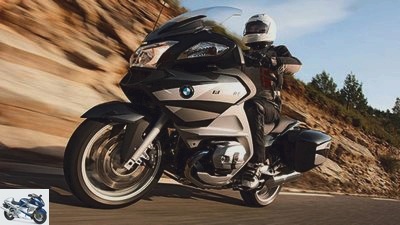
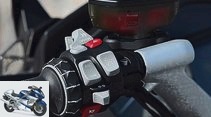

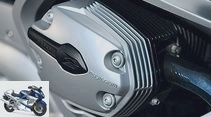
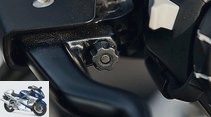
16 photos
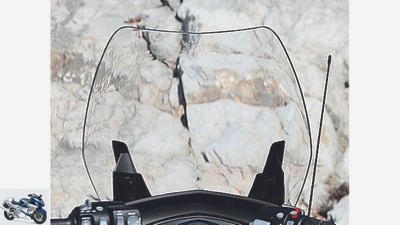
Jahn
1/16
The windshield of the old BMW R 1200 RT.
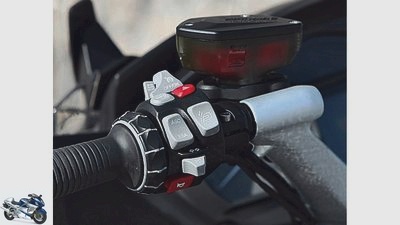
Jahn
2/16
There are still so many switches on the new BMW R 1200 RT, but there is now a smart control ring for the radio.
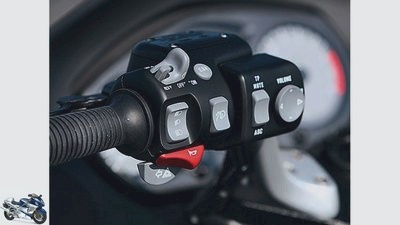
Jahn
3/16
Even with the old BMW R 1200 RT, operating the many switches is a challenge.
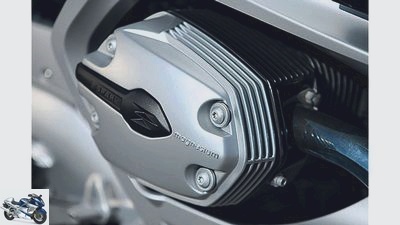
Jahn
4/16
The cylinder head cover of the old BMW R 1200 RT.
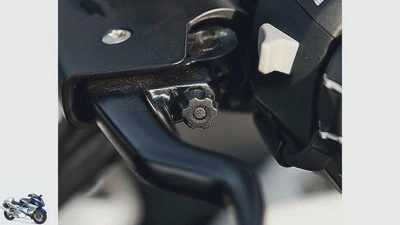
Jahn
5/16
In return, the hand lever of the new BMW R 1200 RT is much better in the hand.
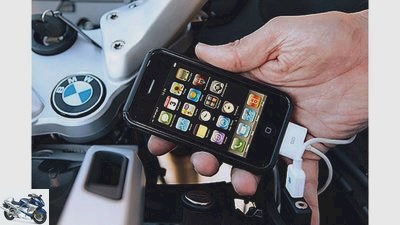
Jahn
6/16
Thanks to the USB port, an MP3 player or an iPod can be plugged into the new audio system.
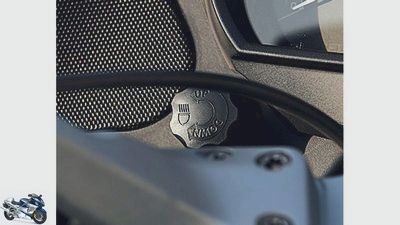
Jahn
7/16
In addition, the headlight range can now be adjusted at lightning speed using the handwheel in the cockpit, depending on the load.
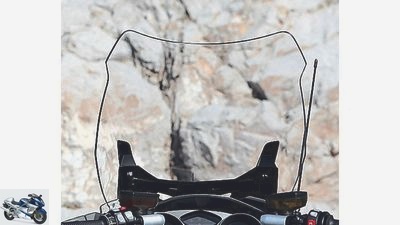
Jahn
8/16
The window of the new BMW R 1200 RT reduces distortion and thus enables a better view.
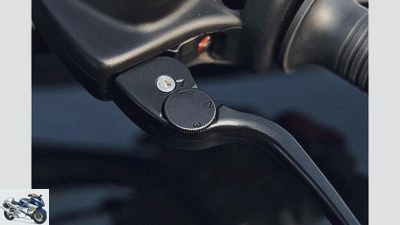
Jahn
9/16
Clearly more practical with the old BMW R 1200 RT. The reach adjuster of the hand lever.
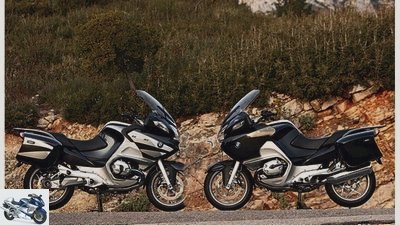
Jahn
10/16
Old against new. Even if the new BMW R 1200 RT has become better thanks to the revision, the old one also offers top comfort.
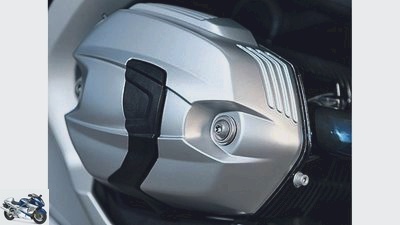
Jahn
11/16
According to BMW, the cylinder head cover of the new R 1200 RT should be styled more dynamically. You can see it like that, but you don’t have to.
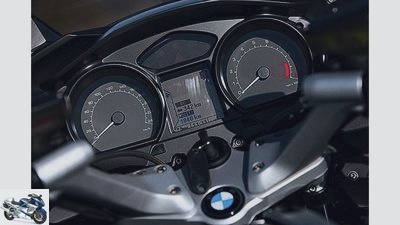
Jahn
12/16
The sight of the new fittings remains as usual. Only the glare rings are new and reduce a little annoying reflections.
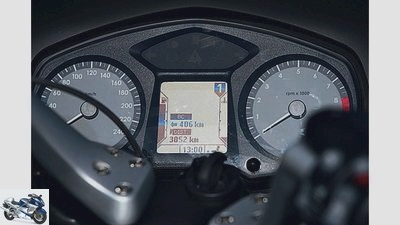
Jahn
13/16
The fittings of the old BMW R 1200 RT.

Jahn
14/16
A few small gimmicks still need to be mentioned on the new BMW R 1200 RT.
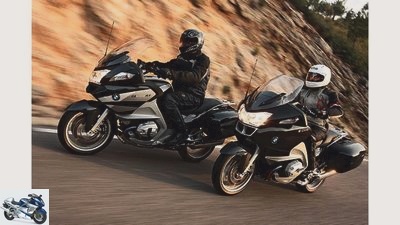
Jahn
15/16
The comparison shows what has changed most on the R 1200 RT.
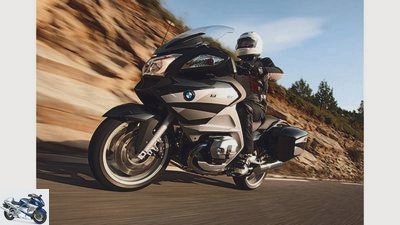
Jahn
16/16
Successful operation: fine-tuning of shape and design makes the new BMW R 1200 RT more dynamic.
Top test BMW R 1200 RT – old against new
The touring boxer compared to the previous model
The new RT is not really new. Bad news? More like a good one. Because the current fine-tuning of the engine, fairing and chassis makes the touring boxer even better. How much is shown by a direct comparison with the previous model.
Perhaps with some motorcycles it is like wine, which it is usually better not to taste fresh, but rather to mature for a few years. Those familiar with the subject know: Motorcycles are also often best when they have been on the market for a few years, when errors and quirks in the first production batches have been corrected, when they have achieved an extraordinary level of maturity and quality after one or two updates.
This certainly applies to the boxer models from BMW. The boxer in general has been partly openly planed and polished in the past decade, but partly without fuss, so that many criticisms of the past are no longer an issue. And there have been quite a few of them since the four-valve boxer generation came onto the market in 1993. Annoying constant speed jerking, delayed throttle response, sticking gearshifts, cracking noises in the drive train, problems with the brake booster ABS – none of this is an issue today, or at least it has improved considerably in the past few years. And the RT in particular is now undergoing an upgrade with many small changes, which should further enhance its undisputed tourist qualities (see driving report in MOTORRAD 5/2010).
Buy complete article
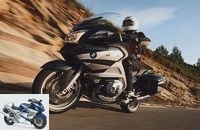
Top test BMW R 1200 RT – old against new
The touring boxer compared to the previous model
Jahn
Successful operation: fine-tuning of shape and design makes the new RT more dynamic. Above is the earlier model, the test machine is currently for sale at Motorrad Gruneberg from Villingen-Schwenningen.
And while we’re at the comparison with the K models: The boxer doesn’t have to hide in terms of the chassis either. While the Duolever of the K is very stiff, but reacts rather bumpily to edges and breaks in the asphalt, the long-stroke Telelever of the RT simply irons away everything that the southern French road construction has in store for surprises and nastiness. A really excellent ride comfort of the highest level, which no other tourer can offer in this quality.
With the small disadvantage that the front suspension swallows the feedback and feeling for the front wheel in addition to all the rough terrain. This is particularly noticeable when switching from a motorcycle with conventional chassis technology; the first few meters on a Telelever boxer take getting used to. Incidentally, this applies even more to the 2008 test machine, which was fitted with Bridgestone BT 020 tires. The Metzeler Roadtec Z6s of the new RT build trust more quickly. In general, the Metzeler with more neutral steering behavior and better grip – especially in cold and wet conditions – are the better choice, even if the Bridgestone provide more stability at high speeds.
The new expansion stage of the ESA electronic chassis works with the same settings as before, but the additional adjustment of the spring rate on the rear strut enables a wider setting range. That is not necessarily decisive for the war in solo operation. But especially with a high load, there are now more reserves at the rear, the RT looks more stable and tighter with a sporty setting.
Jahn
Pure touring luxury: You can’t get more comfort, whether old or new RT, alone or as a couple.
Slight progress – under this motto one could also classify the effects of the interventions on plastic clothing. In direct comparison, the new cladding appears less flat. Although the external shape has changed little, BMW was able to improve the wind protection. This is mainly due to the disc, which is now wider in the upper area. It’s nice that this effect is particularly noticeable in the speed ranges that are common on country roads. The current circumnavigates the upper body area less turbulently, so you can drive very relaxed with the windshield slightly raised in terms of noise and wind protection. The old model always needs a higher setting for the same effect, at which the edge in the field of vision is then disturbing. Most of the tourists are only on the highways when they are on the high road, and the new window improves visibility through less distortion. The front passenger also benefits a little from the aerodynamic advantages of the new windshield. Incidentally, according to BMW, it also fits the old model.
The workplace has also been renovated. Ergonomically everything stayed the same, unfortunately the desire for an adjustable handlebar remained unheard of. The existing one puts particularly tall drivers in the supine position, and with a hollow back the driving experience is quite passive. In terms of comfort, however, there are no objections, the RT workstation is still one of the most convenient of all. The operation of the radio represents a step forward, the ugly knob is no longer necessary in favor of a simple operating ring on the handle. Knubbel is now available in the form of towering containers for the hydraulic fluids, which thanks to rubber bearings shake strangely on bumpy roads. Everyone can judge for themselves whether this is a step forward compared to the integrated solutions in the previous model. The same applies to activating the indicators, which has always polarized. The previous BMW solution with three counters had its fans, and those switching from other makes will certainly prefer the conventional solution of the new model.
And they will probably be the target group in the first place. Because if you already have an RT, you don’t have to sell it cheaply for the new model.
MOTORCYCLE measurements
archive
Power on the crankshaft. Measurements on Dynojet roller test stand 250, corrected according to 95/1 / EG, maximum possible deviation +/- 5%
As promised, the new Dohc engine delivers more power, especially in the important medium speed range. In addition, the wave troughs are somewhat leveled in the torque curve. Both RT models remain slightly below the nominal output, the new one outperforms its predecessor by a good two hp. The higher maximum speed is less relevant for a tourer.
Top speed (old model in brackets)*
223 km / h
acceleration
0 100 km / h 3.9 (3.9) sec
0 140 km / h 6.1 (6.3) sec
0-200 km / h 15.3 (15.6) sec
Draft
60-100 km / h 4.8 (5.0) sec
100-140 km / h 4.9 (5.2) sec
140-180 km / h 6.8 (7.2) sec
Speedometer deviation
Effective (display 50/100) 48/96 km / h
Tachometer deviation
Display red area 8500 rpm
Effective 8500 rpm
consumption
Country road 4.9 l / 100 km
At 130 km / h 5.6 l / 100 km
Theor. Range of the country road 551 km
Fuel type Super Plus
mass and weight
L / W / H 2160/990/1420 mm
Seat height 830-850 mm
Handlebar height 1070 mm
Turning circle 5750 mm
Weight with a full tank 282 kg
Payload 213 kg
Wheel load distribution f / r 51/49%
* Manufacturer information
Brake measurements
archive
MOTORCYCLE test course, values from the brake test averaged from the three best driving tests.
The consistently high level of deceleration without any dips leads to extremely short braking distances. In doing so, the Telelever fork prevents the vehicle from dipping away despite a long delay. The rear wheel maintains contact with the ground even when braking hard. Therefore, the RT remains stable on course. All in all, it is relatively easy to slow down the RT at the limit.
Brake measurement from 100 km / h
| Braking distance | 39.7 m |
| Reference BMW K 1200 R Sport | 37.0 |
(Reference: motorcycle from the respective category with the previous best values)
Technical data of the new R 1200 RT
Jahn
Setup country road: With the optional equipment with ESA II, the chassis can be adjusted from the handlebars while driving. The corresponding symbols make setting easy: basic setting Comfort, Normal or Sport, loading solo, with luggage or with two people and luggage. Air pressure 2.2 / 2.5 bar
Engine:
Air / oil-cooled two-cylinder four-stroke boxer engine, one balance shaft, two overhead, chain-driven camshafts, four valves per cylinder, rocker arm, wet sump lubrication, injection Ø 47 mm, regulated catalytic converter, 720 W alternator, 12 V / 19 Ah battery, hydraulically operated Single-disc dry clutch, six-speed gearbox, cardan, secondary ratio 2.62.
Bore x stroke 101.0 x 73.0 mm
Cubic capacity 1170 cm³
Compression ratio 12.0: 1
rated capacity 81.0 kW (110 hp) at 7750 rpm
Max. Torque 120 Nm at 6000 rpm
Landing gear:
Load-bearing motor-gear unit, telescopic fork, Ø 35 mm (with ESA: adjustable rebound damping), two-joint single-sided swing arm made of aluminum, central spring strut, directly hinged, adjustable spring base and rebound damping (with ESA: adjustable spring base, spring rate and rebound damping), double disc brake at the front , Ø 320 mm, four-piston fixed calipers, rear disc brake, Ø 265 mm, double-piston floating caliper, partially integral brake system with ABS.
Cast aluminum wheels 3.50 x 17; 5.50 x 17
Tires 120/70 ZR 17; 180/55 ZR 17
Rear tires in the Metzeler Roadtec Z6 Interact test "C."
Mass and weight:
Wheelbase 1485 mm, steering head angle 63.4 degrees, caster 110 mm, spring travel f / r 120/135 mm, permissible total weight 495 kg, tank capacity / reserve 25.0 / 4.0 liters.
Service data:
Service intervals 10000 km
Oil and filter change 10000 km / 4.0 l
Engine oil SAE10W40
Idle speed 1150 +/- 50 / min
front / rear 2.2 / 2.5 (2.5 / 2.9) bar
Guarantee two years
Mobility guarantee two years
Colours Gray, white, gray / silver
price 16,200 euros
Price test motorcycle * 19080 euros
Additional costs around 269 euros
* including safety package (420 euros) consisting of: ASC and RDC; Touring package (1470 euros) consisting of: ESA, chrome-plated exhaust system, heated grips, heated seats, cruise control, on-board computer and 2nd socket; Audio system (990 euros)
Noticed
plus
- Thanks to the USB port, an MP3 player or an iPod can be plugged into the new audio system
- The range of the shift lever is now adjustable and is made of cast aluminum instead of pressed steel
- The headlight range can now be adjusted at lightning speed using the hand wheel in the cockpit, depending on the load
- Oil filler neck now on the right instead of on the left, which is more practical for filling
minus
- No adjustment option for the handlebar protruding far back
- The shaky hydraulic tanks on the handlebars are no feast for the eyes
- Oil sight glass further on the left side
Conclusion
There’s not a single reason to buy the new RT – there are many. The changes to the engine, chassis and bodywork are by no means serious, but they add up. The bottom line is that the RT remains what it was: an extremely luxurious and comfortable, but despite the extensive equipment, by no means overweight touring boxer with a unique driving feeling.
Scoring
Category engine:
The drive is not the most powerful part of the RT, with 110 HP it is not exactly overpowered. Although the boxer is sometimes a bit sluggish and indirect, it still fits perfectly with the character of a touring machine. Vibrations are undeniably present, but they are never really annoying. Points of criticism remain the dry clutch, which smells foul under load, and the long shift travel of the transmission, which only shifts hard in the two lower gears.
Category chassis:
The handiness of the thick ship is always striking. With the Metzeler Roadtec Z6, the RT circles around bends more neutrally and more precisely, but when it comes to feedback, the Telelever chassis leaves something to be desired. Thanks to the special equipment with ESA chassis, the setting options are varied and clearly noticeable, which means that the RT also collects many points in the pillion rider. The driving comfort on rough roads is outstanding.
Category everyday life:
Comfort is also the buzzword when it comes to ergonomic conditions; both seats are extremely comfortable even on long tours. The RT is also absolute top in terms of equipment, luggage storage, wind protection and light. The large tank enables enormous stages. Overall, not much more is possible in this chapter in terms of points. The deeply placed mirrors alone have to take criticism.
Category Security:
It’s a shame that the brake control is not quite as good as its excellent effect. Even with a pillion passenger, the braking distances are extremely short. The righting moment in curves is within limits, handlebar flapping remains a foreign concept even on extremely undulating roads.
Category costs:
In terms of consumption, the RT has increased a little, 4.9 instead of 4.6 liters are still good in view of the mass and dimensions. Unfortunately, she would like to have Super Plus. A three-year guarantee like Honda’s VFR would of course also be nice.
| Max points |
BMW R 1200 RT |
|
| Overall rating | 1000 | 734 | Price-performance note | Top grade 1.0 | 2.4 |
The price-performance ratio:
An RT is of course not cheap – but good. The high score therefore makes the price appear reasonable.
Technology news
BMW
The cylinder of an old boxer engine.
Trick question: When did BMW build the first boxer? Correctly googled, that was in 1923, the machine was called R 32, back then with a cardan. Visually, the first boxer still has a few things in common with the current one; the outstanding air-cooled cylinders are now more than ever a unique selling point for Bavaria.
Technically, however, practically no stone has been left unturned since then. The last major intervention happened in 1993 when the boxer got four valves instead of two. That also brought a leap in the possible power output. Because the filling with fresh gas is a fundamental shortcoming of the boxer, the outward-facing cylinders result in unfavorable channels that are curved towards the engine block.
Jahn
The cylinder of a new boxer.
In principle, the current expansion stage does not change that. The shape of the channels remained, but the lighter masses of the valve train allow higher valve accelerations, which in turn improves the filling. The maximum speed at which the valves or rocker arms or rocker arms can no longer follow the cam tracks also increases. These better prerequisites for a Dohc head can either be converted into higher peak performance – the HP2 Sport produces at least 130 hp at 8750 rpm – or the torque is maximized at low speeds, as with the RT and GS. In addition, the radially arranged valves result in a compact, less rugged combustion chamber. Nevertheless, BMW left the compression at 12.0, Super Plus is required for full performance.
Related articles
-
Gargolov Top test BMW K 1200 RS / GT 5 star deluxe BMW K 1200 GT ?? even more confident, even more comfortable. At least that’s what the Bavarians…
-
Gargolov Top test BMW K 1200 R I am beautiful? From Stefan Kaschel; Photos: Rossen Gargolov Designing a motorcycle of this caliber just classically…
-
Jahn Top test BMW K 1200 R Sport In the middle BMW is now placing the R Sport between the K 1200 S and R. The top test clarifies what the new,…
-
BMW R 1200 GS model 2013 and 2012 in comparison
Jahn 26 pictures Jahn 1/26 The current change of regent on the BMW R 1200 GS is rightly the most technically incisive of the 33-year-olds …
-
Gargolov Top-Test Kawasaki ZZ-R 1200 Wuchtbrumme A sports tourer, mighty, strong, carved from the solid: the Kawasaki ZZ-R 1200. Certainly not …
-
Top test of the Suzuki V-Strom 650 ABS
Bilski 13 pictures Bilski 1/13 Not just nicely styled. In touring trim, the handy Suzuki V-Strom tempts you to brisk down winding roads …
-
fact Top test BMW R 1200 S The new S The R 90 S and R 100 S tried to establish the S as the epitome of sport in the BMW range. But only the R 1100 S,…
-
fact 24 photos Aprilia 1/24 in the superbike variant Aprilia 2/24 Aprilia RSV4 superbike. Aprilia 3/24 Aprilia RSV4 superbike. Aprilia 4/24 Aprilia RSV4…
-
BMW R 1200 R and Yamaha YZF-R6 same performance class
24 pictures 1/24 BMW R 1200 R and Yamaha YZF-R6 in the test. 2/24 BMW R 1200 R and Yamaha YZF-R6 in the test. …
-
Jorg Kunstle Top-Test Yamaha FZ1 / Fazer Are you going now? We had to wait a long time for that: a naked Nippon athlete. Not washed soft, but …